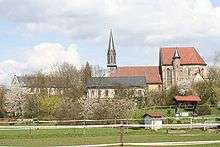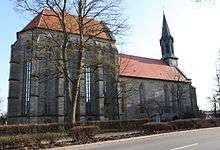Sonnefeld Monastery


The Sonnefeld Monastery is the former Cistercian nunnery in Sonnefeld in Bavaria, Germany. The Klosterkirche (“Monastery Church” in German) is now an Evangelical Lutheran parish church.
History
Foundation
The Monastery, dedicated to the Blessed Virgin Mary, was founded in 1260 by Henry II von Sonneberg and his wife Kunigunde. The Monastery was at the beginning in Ebersdorf bei Coburg but, after a great fire in 1267, it was moved to Hofstädten. But the Monastery and its surrounding settlement and district adopted Sonnefeld as their names and kept it until 1889, when Sonnefeld and Hofstädten merged to become Sonnefeld. The landlord at the beginning was the Prince-Bishop of Bamberg, Berthold von Leiningen, who tried to stop the foundation and also the advances of the Counts von Hennebergs. The spiritual leader was the Bishop of Würzburg. The settlement was made by the nuns from the Maidbronn Abbey. It included the nearby villages of Frohnlach and Ebersdorf. In 1262, the Abbots of Ebrach and Bildhausen inspected the progress and provided for the recognition of the Order.
Development
The Monastery's founder Henry II was also among the witnesses of the foundation of the Himmelkron Abbey. The Sonnefeld Monastery was Henneberger. Under Abbess Anna von Henneberg, whose epitaph has been preserved, it flourished. The decline began as early as the 14th Century. The number of nuns had risen beyond the economical limits and had to be restricted to 50 people. The provisions for the maidens and widows of the nobles and commoners soon became the focus of the monastic life. Private property became common, contrary to the rules of the Cistercian Order. But the number of recruits decreased. Under Abbess Margaretha von Brandenstein (ca 1460–1503), the Monastery flourished for the last time, because the Abbess had managed the debts and began several construction projects. In 1504, most of the nuns turned against the Abbess, because they wanted to introduce the Claustration again. The Abbott of the Georgenthal Abbey was employed as a Visitor and detained some of the nuns.
Possessions
Beginning with the former Bamberger fiefs of Sonnefeld, Frohnlach and Ebersdorf, the Monastery multiplied its possessions with other properties from Bamberg, the Banz Abbey and the Benedictine abbey of Saalfeld. A papal letter of protection of 1291 named 34 localities. The Monastery grew until the end of the Middle Ages as one of the largest landowners in the Coburger Land. It had an almost complete dominion over Weißenbrunn vorm Wald. There were also regular donations from local noble families, especially the Schaumberg family and the Marshals von Kunstadt. Since 1331 the Monastery had the right of residence in a townhouse in Bamberg at Grünen Markt and was the owner of a few houses in Coburg. Through Anna von Henneberg the Monastery also came into the possession of vineyards in Nüdlingen and Nassach.
End of the Monastery
In 1524 a Lutheran preacher had the nuns to defy the wishes of the last Abbess Margaretha von Zedtwitz by a Lutheran preacher. When the Abbess died a year later, the Council of John, Elector of Saxony appointed an administrator for the Monastery's properties. Five of the 14 nuns left the Monastery in favor of the worldly life, and the last of the remaining nuns died in 1572. The property then fell to the territorial sovereignty of Saxe-Coburg as a district. Anna of Saxony spent several years of her captivity in the former monastery and was buried in the Klosterkirche.
Abbesses of the Monastery
- Agnes, presumably von Sonneberg, 1264
- Irmengardis, presumably von Sonneberg, 1276
- Jutta von Meißen, 1287–1289Epitaph of Anna von Henneberg
- Elisabeth von Henneberg, 1296
- Mechtildis von Sonneberg from Lichtenfels, 1302–1303
- Jutta II von Henneberg-Coburg, 1304
- Agnes II, presumably von Sonneberg, 1305
- Mechtildis II from Lichtenfels, 1305
- Agnes III, presumably von Sonneberg, 1306, possibly identical with Agnes II
- Jutta III von Henneberg from Lusatia, 1306–1325Arms of Dorothea von Kemmaten
- Sophia, 1328
- Margaretha, 1329–1334
- Ottilia, 1334
- Margaretha II Marschalk, 1335–1344
- Ottilia II Truchseß, 1345–1351
- Adelheidis Marschalk, 1354–1360
- Felicitas, 1362–1363
- Anna von Henneberg, died circa 1363, not included by Wank because of lack of dates
- Margaretha III von Heldritt, 1364–1375
- Elisabeth II von Lichtenstein, 1379–1386
- Anna Marschalk, 1390–1396
- Barbara von Smeheim, 1398
- Katharina von Füllbach, 1401–1406
- Dorothea von Gotlecher, 1408
- Katharina II von Füllbach, 1409–1419, probably identical with Katharina I
- Barbara II von Walsberg, 1425–1430
- Margaretha IV von Giech, 1433–1437
- Elisabeth III, 1441–1448
- Dorothea II von Kemmaten, 1454–1455, whose arms are on the keystone
- Margaretha V von Brandenstein, 1462–1503
- Dorothea von Pfersfeld, 1503–1515
- Margaretha von Zedtwitz, died 1525, according to Wank, also Margaretha VI von Brandenstein (1515–1531)
Construction of the Monastery and Church
The church was built, according to the style of the Cistercians, next to the choir and nave with an adjacent walk-in vault, above which was the gallery for the nuns. The choir area was the work of Heinrich Parler but its character was partially lost to fires and renovations. Among other things, the roof turret, a Parler trademark, was removed. Only a few gravestones have survived from the monastery's days as the reminders of Abbess Anna von Henneberg and a Schaumberger knight. The Klosterkirche became the parish church for the Protestants in 1520. The previous parish church is the present cemetery church, St. Moritz.
In 1634 the monastery and church burned to the ground. In 1856, they were restored. Of the monastery only a part of the east wing is preserved. A keystone in the arch bears the arms of Abbess Dorothea von Kemmaten (circa 1453). The remains of the paintings from the 2nd half of the 15th Century can still be seen.
The entire monastery area consisted of several buildings, which were surrounded by a moat. The buildings, besides the residences, were used mostly for the agriculture and the administration. One of them was operated as the Monastery's mill. The buildings also included a district office, a Fronfeste (fortified bridge) and a school.
Literature
- (de) Harald Bachmann: Sonnefeld - Geschichte und Gegenwart (Sonnefeld – Past and Present). Sonnefeld, no date.
- (de) Joachim Hotz: Zisterzienserklöster in Oberfranken (Cistercian Monasteries in Upper Franconia). In: Große Kunstführer. Bd. 98 (Great Art Leaders, Vol. 98), Munich and Zurich, Schnell und Steiner, 1982, ISBN 3-7954-0842-3, pp. 64–70.
- (de) Walter Lorenz, et al.: 700 Jahre Sonnefeld 1252 - 1952 (700 Years of Sonnefeld 1252 - 1952). Coburg, Veste-Verlag, 1952.
- (de) Hans Roser: Klöster in Franken (Monasteries in Franconia). Freiburg, Eulen Verlag, 1988, ISBN 3-89102-108-9, p. 224 ff.
- (de) Hermann Wank: Markt und Kloster Sonnefeld (Market and Monastery of Sonnefeld). Coburg, 1925.
External links
- (de) For more details: “Sonnefeld”, and for history: Zisterze Sonnefeld – Hoffnung auf ewige Fürbitte (Cistercian Sonnefeld – Hope of Eternal Intercession in the Klöster in Bayern (Monasteries in Bavaria) database from the Haus der Bayerische Geschichte (House of Bavarian History).
Coordinates: 50°13′18″N 11°08′03″E / 50.22167°N 11.13417°E